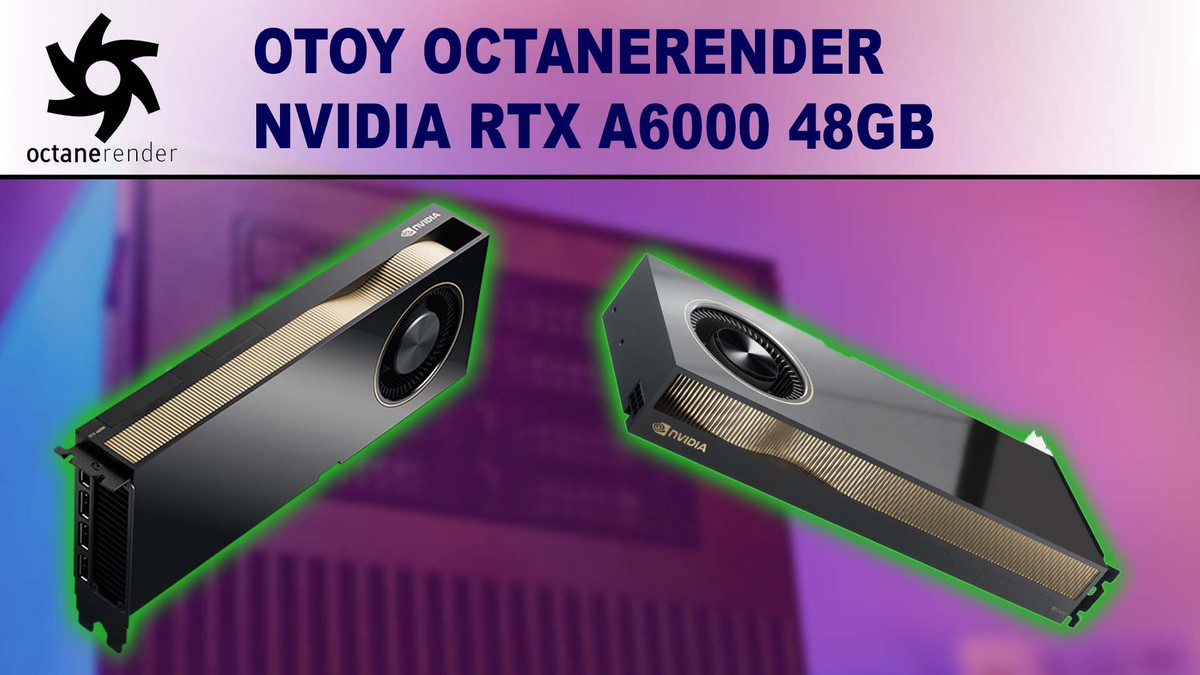Table of Contents
TL;DR: NVIDIA RTX A6000 48GB performance in OctaneRender
With nearly a 70% increase in rendering performance of the previous generation Quadros, the RTX A6000 is a great card for Octane. While the NVIDIA RTX A6000 is ideal for rendering large scenes with its 48GB of VRAM and NVLink support, there are less expensive options in the GeForce line with less VRAM, a trade-off that will be acceptable for many users.
Introduction
NVIDIA has launched their new GeForce RTX 30 Series video cards in a set of rolling releases during the fall of 2020 and has touted major advancements in performance and efficiency with this "Ampere" architecture. Those were all consumer-grade video cards, however, now we are finally able to take a look at the first workstation card with this architecture, the RTX A6000. NVIDIA has decided to forgo the “Quadro” designation this generation, but the RTX A6000 is a direct successor to the Quadro RTX 6000/8000. Professional applications like OTOY's OctaneRender should see significant improvements with this card.
If you want to see the full specs for the latest GPUs from NVIDIA, we recommend checking out the NVIDIA Quadro product pages. But at a glance, here are what we consider to be the most important specs:
| VRAM | Cores | FP32 Performance | Power | MSRP | |
|---|---|---|---|---|---|
| Quadro RTX 4000 | 8GB | 2,304 | 7.1 TFLOPS | 160W | $449 |
| Quadro RTX 5000 | 16GB | 3,072 | 11.2 TFLOPS | 265W | $2,300 |
| Quadro RTX 6000 | 24GB | 4,608 | 16.3 TFLOPS | 295W | $4,000 |
| RTX A6000 | 48GB | 10,752 | 38.7 TFLOPS | 300W | $4,650 |
| Quadro RTX 8000 | 48GB | 4,608 | 16.3 TFLOPS | 295W | $5,500 |
While specs don't always line up with real-world performance, it is a great sign that NVIDIA has roughly doubled the number of CUDA cores compared to the Quadro RTX Series cards. The RTX A6000 replaces both the Quadro RTX 6000 and 8000.
Puget Systems offers a range of powerful and reliable systems that are tailor-made for your unique workflow.
Test Setup
Listed below is the specifications of the system we will be using for our testing:
| Test Platform | |
| CPU | AMD Ryzen 9 5900X12-Core |
| CPU Cooler | Noctua NH-U12AP |
| Motherboard | Gigabyte X570 AORUS ULTRA |
| RAM | 4x Crucial DDR4-3200 16GB (64GB total) |
| Video Card |
Quadro RTX 4000 8GB |
| Hard Drive | Samsung 960 Pro 1TB |
| Software | Windows 10 Pro 64-bit (Ver. 2009)
OctaneBench 2020.1.5 |
*All the latest drivers, OS updates, BIOS, and firmware applied as of Jan 20th, 2020
To test each video card, we used OctaneBench 2020.1.5. These tests were run twice on each GPU, with the best result being included in the graphs below.
Benchmark Results
Here are charts showing the performance of the new RTX A6000 (in dark green) compared to the other cards we tested:
Performance Analysis
The raw performance of the new RTX A6000 is amazing in Octane! In both tests, the new card is 70% faster than the previous Quadro RTX 6000/8000. It also offers a massive 48GB VRAM, equaling the RTX 8000, while costing a few hundred dollars less. If you are looking for the top of the line video card with the highest amount of VRAM, this is as good as it gets.
We do not have results for multiple A6000s yet, but we will soon. We are hoping that we’ll see a similar scaling with multiple cards. It has a lower power draw than the GeForce RTX 3090, so we are cautiously hopeful that we will be able to have 4 cards in a system.
How well does the NVIDIA RTX A6000 48GB perform in Octane?
The NVIDIA RTX A6000 is ideal for rendering large scenes with its 48GB of VRAM and NVLink support. Nearing a 70% performance increase compared to the previous generation Quadros. There are less expensive options in the GeForce line with less VRAM, a trade-off that will be acceptable for many users. We also do not know what NVIDIA has planned for lower-tiered Ampere cards. We are hoping they we reveal an RTX A5000 and A4000 at some point in the future, but so far they have been silent.
As always, please keep in mind that these results are strictly for GPU-based rendering in Octane. If you have performance concerns for other applications in your workflow, we highly recommend checking out our Hardware Articles (you can filter by "Video Card") for the latest information on how a wide range of programs perform with various GPUs, CPUs, and other hardware.
Puget Systems offers a range of powerful and reliable systems that are tailor-made for your unique workflow.

